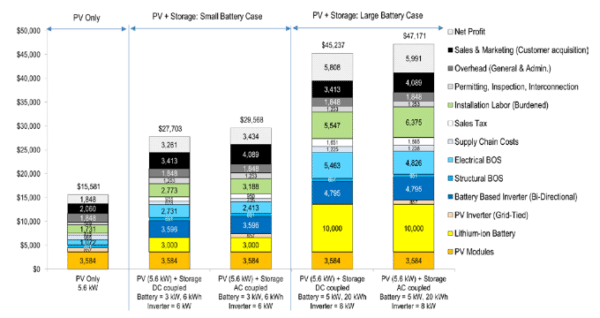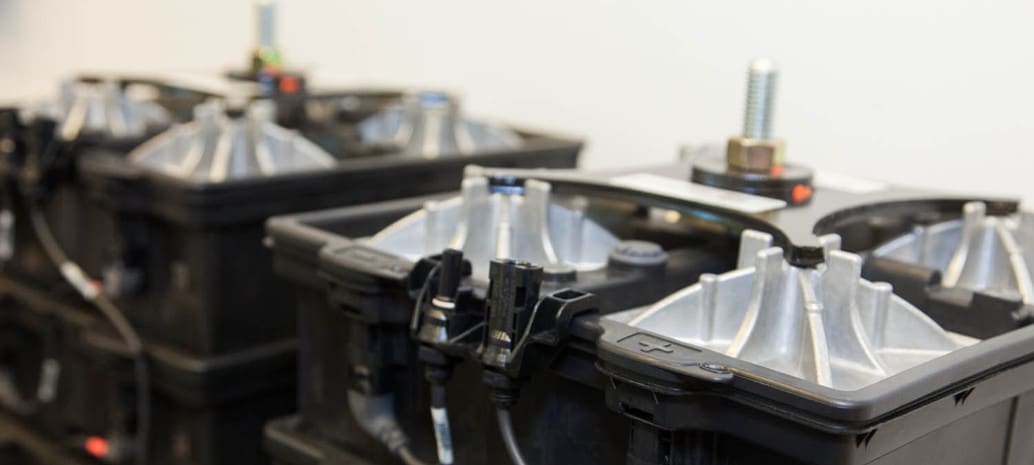Despite ongoing cost declines for lithium-ion battery technology, residential battery storage systems still aren’t cheap. And with a wide range of products, system designs and soft costs, consumers and even many in the solar industry may not be clear as to how much the typical residential solar-plus-storage system should cost.
Until this week. On Tuesday, the U.S. Department of Energy’s (DOE) National Renewable Energy Laboratories (NREL), in collaboration with Rocky Mountain Institute and the DOE, released a report to look at typical costs of residential PV paired with energy storage, as well as barriers to deployment and opportunities for cost reduction.
To arrive at its cost figure, NREL used the bottom-up cost-modeling approach which has allowed it to provide definitive national figures for installed PV costs, and applied it to the solar-plus-storage landscape.
Some aspects of this approach had to be modified. Given that batteries are rated both on capacity (kilowatts or kW) and energy (kilowatt-hours or kWh), NREL had to scrap its cost-per-watt metric and settle on a typical PV system size of a 5.6 kW, paired with either a small (3 kW/6kWh) or a large (5 kW/20 kWh) battery. The report then further looks at a variety of cases, such as DC or AC coupling, and battery retrofits versus installing a PV system with storage.
The result is that adding even the small battery to a residential PV system nearly doubles its cost, from $15,600 to $27,700 to $29,600, depending on whether DC or AC coupling is used. Retrofits come in at $32,800 – meaning $17,200 to add a small battery.
For larger systems, the costs are even higher, with NREL modeling the typical 5.6 kW PV system with a 5 kW/20kWh battery at $45,200-$47,200 – again, depending on whether or DC or AC coupling is used. In both cases costs are pretty evenly split between “hard” or component costs and “soft” costs, with small batteries representing a roughly 50/50 split and the larger systems tilted 60/40 in favor of hardware.

Included in the report’s assumptions is a 17% profit margin for the installer, however NREL notes that profit margins and available incentives can vary widely.
The National Lab notes that this is one of the most detailed breakdowns of the cost of residential energy storage available to date and describes a gap in existing literature, particularly around soft costs.
“There is rapidly growing interest in pairing distributed PV with storage, but there’s a lack of publicly available cost data and analysis,” said Kristen Ardani, lead author of the report and a solar technology markets and policy analyst at NREL.
It is worth noting that while residential energy storage costs are high, they have not prevented a market from developing across the United States. Many analysts note that the choice by a homeowner to install a battery system is often not an economic one, but rather represents that homeowner’s desire to continue to have electricity in the event of an outage, which can be hard to quantify.
Missing valuation
In addition to examining costs, NREL also takes a look at barriers to the emergent PV-plus-storage market, describing “inconsistent permitting processes, complexity in adequately valuing the benefits of energy storage, and flat utility rates”.
The second of these – a failure to value the benefits of energy storage – is something that has been identified as a central challenge for both utility-scale and distributed energy storage markets. Many grid operators do not have mechanisms to provide compensation or even to value many of the services that energy storage can provide, particularly at the distributed level, as addressed in a recent report by City University of New York.
This is particularly true for the resiliency benefits that energy storage can provide in the event of outages, which is something that New York City became intimately familiar with in the aftermath of Hurricane Sandy.
And while in many places having battery power in the event of an outage is seen as something of a luxury, in some states batteries are becoming an essential part of residential PV systems. Hawaii’s new self-consumption regulations essentially require the pairing of PV plus storage, and time-of-use rates and other changes to rates and net metering programs are making storage more and more important.
This will not be NREL’s last look at this subject. Similar to its work with PV, the National Lab says that this is only the first in a planned series of solar-plus-storage reports to document progress in cost reductions for this emerging market segment.
This content is protected by copyright and may not be reused. If you want to cooperate with us and would like to reuse some of our content, please contact: editors@pv-magazine.com.









In Hawaii, high minded 100% renewable State level goals have run into short sighted PUC policy adoption (canceling the NEM program) driven by utility provided, monopoly protecting misinformation. In the face of solid evidence and sound electrical engineering the utility that serves all but one of the islands continues to argue for system level PV hosting capacity limits at the current 11-14% of load level. The island of Kauai is an electrical coop outside of the utilities grip. It is currently, without incident operating at over 70% PV supply of load.
The utilities own engineers have stated that the current PV levels can triple safely with simple, inexpensive Load Tap Changer settings. Independent engineering studies, commissioned by the utility stated that there is room for an additional 134 mW of unregulated PV without a threat to hosting capacity. National laboratory dynamic testing has proven that PV penetration levels three times higher than current levels pose no threat to the grid.
Permits have dropped from an average of 300-500 per week during the NEM period to the current average of 30-40 per week without NEM. Most of the current permits are for old left over, prior approved NEM systems which are only now being installed. Current new battery system permits are averaging fewer than 5 per week.
The utility is working hard teaching the PUC how to perfect “the slow walk” in order to protect their economic monopoly on energy supply.
The utility has succeeded at getting the PUC to force home owners into non economically viable battery systems as the only choice available. The math, real world application and science speaks for itself.
Those are not real world numbers for a do it your selfer buying most equipment on sites like E-Bay. One can also work around not getting permits because it is a stand alone system like a portable back up generator only using it while disconnected from the grid.
My system while still only one kilo watt of solar array with four kilowatts of pure lead batteries and 6.5kw pure sine wave 220v inverter cost about $3500.00 installed after the 30% tax credit. This system can pretty much run my 1000 sqft house about 8 months a year here in San Diego. Cost for grid energy from SDGE is 17 cents a KWH for five hours a day, 25 cents a KWH for 13 hours a day and 37 cents a KWH for six hours a day.
This system is not that difficult to put together. What is difficult is getting reasonable information through the big smoke screen of technical jargon and a multitude of products.
I will be increasing this system as much as I can before the tax credit expires.